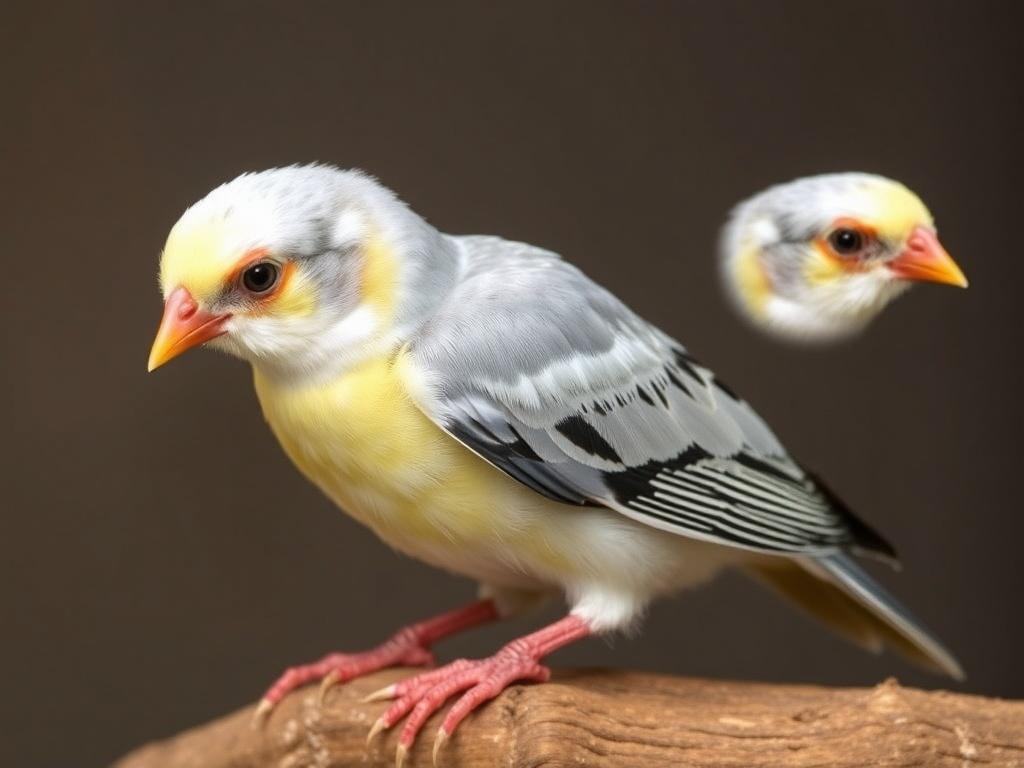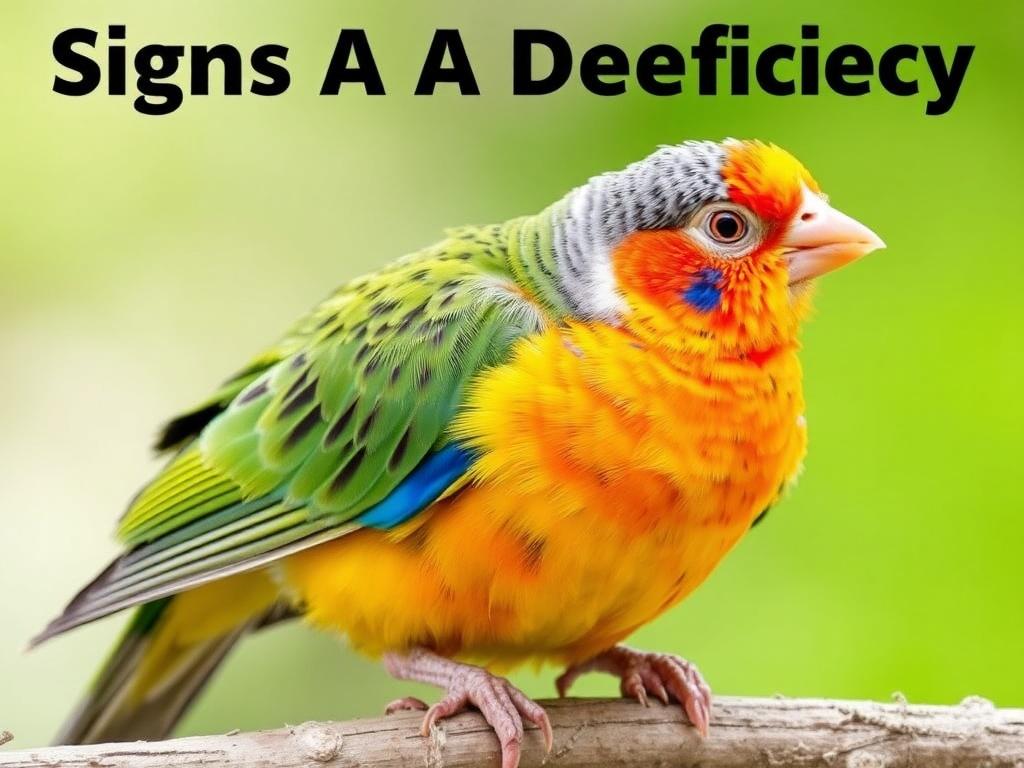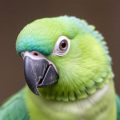Содержание
- Why Vitamin A Matters to Birds
- Who’s at Risk?
- Early Behavioral and Physical Signs
- Clearer Clinical Signs: What Owners Often See
- System-by-System: A Table of Signs
- How Veterinarians Diagnose Vitamin A Deficiency
- Treating Vitamin A Deficiency: General Principles
- Foods That Help: Building a Vitamin-A–Friendly Menu
- How Much Is Enough — and How Much Is Too Much?
- Species-Specific Differences
- What Else Can Cause Similar Signs?
- Monitoring Recovery: What to Expect
- Prevention Is the Best Strategy
- Home Care Tips While Waiting for Veterinary Care
- Case Examples: How Signs Present in Real Life
- Summary Checklist: Spotting Vitamin A Deficiency
- Resources and Talking Points for Your Vet Visit
- Conclusion
SQLITE NOT INSTALLED
Birds are elegant, noisy, and often full of life — and when something is off, their behavior and appearance tell a story. One of the subtler but common nutritional problems in captive and domestic birds is a lack of vitamin A. It doesn’t always shout for attention the way a broken wing would, but over time vitamin A deficiency can undermine a bird’s health in ways that are avoidable if you know what to look for. In this article I’ll walk you through the signs of vitamin A deficiency in birds, why it happens, which species are most at risk, how professionals diagnose it, and practical ways to prevent and manage it. I’ll keep things simple and conversational, so whether you are a seasoned aviculturist or a new bird owner, you’ll feel confident spotting the warning signs and taking sensible next steps.
If you expected a list of keyword phrases to weave into this piece — I didn’t receive any specific keywords from you. I’ve focused on naturally using the phrase Signs of Vitamin A Deficiency in Birds throughout the article and covering the subject thoroughly. Now let’s dive into the signs and signals that your bird might be asking for help.
Why Vitamin A Matters to Birds
Vitamin A is a fat-soluble vitamin that plays many critical roles in a bird’s body. It’s essential for healthy skin and mucous membranes (lining of the eyes, respiratory and digestive tracts), proper immune function, growth, and reproduction. In birds, vitamin A is usually obtained as provitamin A carotenoids (like beta-carotene) from plant-based foods and then converted into active vitamin A in the body.
When vitamin A is insufficient, the most immediate consequences typically involve the surfaces that depend on healthy epithelial tissue — the skin, the lining of the mouth, throat, sinuses, and airways, and the digestive tract. Over time, immune defenses weaken, reproduction can be impaired, and secondary infections take hold. The progressive nature of deficiency means early signs are subtle; catching them early avoids long-term damage.
Who’s at Risk?
Certain birds are particularly vulnerable to vitamin A deficiency:
- Pet parrots (budgerigars, cockatiels, conures, African greys, cockatoos, macaws) kept on seed-only diets.
- Finches and canaries fed mainly seed mixes with little fresh vegetation.
- Poultry kept on inappropriate feed or with limited access to fresh vegetables.
- Hand-reared chicks or nestlings that are fed unbalanced formulas or foods lacking carotenoids.
- Any bird with chronic illness, poor appetite, or digestive problems that impair absorption of nutrients.
Understanding risk helps you prioritize prevention. Many commercial pelleted diets are formulated to meet vitamin needs, but owners who rely on seed-only feeding or inconsistent fresh food exposure increase the risk markedly.
Early Behavioral and Physical Signs

The earliest signs of vitamin A deficiency in birds can be behavioral or subtle physical changes. These are often missed because birds are stoic and mask illness until it’s advanced. Watch for these early indicators:
- Decreased activity, less vocalization, or sleeping more than usual.
- Loss of appetite or picky eating, especially avoidance of fresh vegetables.
- Poor feather quality — dull feathers, excessive molting, or brittle shafts.
- Slightly swollen or dry patches around the nostrils (nares) or eyes.
These signs don’t confirm a diagnosis by themselves, but they should prompt closer observation and dietary review. If you notice several together, especially in a bird on a seed-heavy diet, vitamin A deficiency is a plausible factor.
Clearer Clinical Signs: What Owners Often See
As deficiency progresses, more distinct and troublesome signs appear. These are the classic “red flags” that often bring birds to an avian veterinarian:
- Swollen or blocked nostrils (rhinitis) with thick, cheesy discharge.
- Conjunctivitis — red, swollen, or crusty eyes with discharge.
- Respiratory noise, wheezing, sneezing, or labored breathing due to airway irritation.
- Mouth lesions — white or yellowish plaques, or thickened, dry, and rough mucous membranes in the mouth and throat.
- Difficulty swallowing or regurgitation because the oral and throat tissues are unhealthy.
- Frequent secondary infections, particularly bacterial or fungal, because immune defenses are compromised.
Many owners describe seeing “cheesy” plugs around the beak or nares; this is a common sign in parrots and helps distinguish vitamin A deficiency from other causes. Respiratory signs may be mistaken for a cold or infection, but if they come with oral or conjunctival changes and poor diet history, think vitamin A.
System-by-System: A Table of Signs
| Body System | Signs Noted | Why It Happens |
|---|---|---|
| Respiratory | Sneezing, wheezing, nasal discharge, labored breathing | Vitamin A keeps respiratory epithelia moist and functional; deficiency causes thickening, plugging, and secondary infection |
| Ocular | Conjunctivitis, swollen lids, discharge, poor vision in severe cases | Eye mucous membranes degrade, predisposition to infection and corneal problems |
| Oral/Digestive | Cheesy plaques, rough or thickened mucosa, swallowing difficulty, regurgitation | Poor epithelial integrity and increased keratinization of mucous surfaces |
| Skin/Feathers | Dry skin, flaky patches, poor feather quality, increased molting | Disruption of skin cell maturation and feather development |
| Immune function | Frequent infections, poor recovery, slow healing | Vitamin A is critical for immune cell function and barrier integrity |
| Reproductive | Poor egg production, brittle eggs, developmental problems in chicks | Vitamin A supports embryonic development and reproductive tissues |
How Veterinarians Diagnose Vitamin A Deficiency
Diagnosis is a combination of history, clinical signs, and testing. Here’s what an avian vet typically does:
- Detailed diet and husbandry history — the most revealing part for nutritional problems.
- Full physical exam, with careful inspection of the eyes, nares, oral cavity, skin, and feathers.
- Diagnostic sampling — swabs of nasal or oral discharge for cytology and culture to detect secondary infection.
- Bloodwork — complete blood count and chemistry panels help evaluate overall health and may show signs consistent with chronic disease. Specific vitamin A blood levels are possible but not always readily available or definitive.
- Imaging — radiographs or endoscopy in cases where airway obstruction or internal lesions are suspected.
Veterinarians rarely rely on a single test result. Instead, they draw a picture from clinical signs, dietary history, and response to dietary correction or therapy.
Treating Vitamin A Deficiency: General Principles

Treatment focuses on three main goals: correct the deficiency nutritionally, treat secondary infections or complications, and protect damaged tissues while the bird recovers. Key elements include:
- Dietary correction — introducing appropriate vitamin A–rich foods and, if necessary, switching to a nutritionally balanced pellet-based diet. Fresh vegetables rich in beta-carotene are central to recovery.
- Medical therapy — antibiotics or antifungals to treat secondary infections, as indicated by culture or clinical judgment.
- Supportive care — fluids, nutritional support, and sometimes topical treatments (eye or nasal drops) to soothe inflamed mucous membranes.
- Follow-up — re-evaluation to ensure clinical signs resolve and no longer need ongoing medication.
A caution: vitamin A is fat-soluble, and excess supplementation can cause toxicity (hypervitaminosis A). Never give human supplements or high-dose vitamins without veterinary guidance. Correcting the diet gradually and under professional advice is the safest route.
Foods That Help: Building a Vitamin-A–Friendly Menu
Many owners worry that feeding “more vitamin A” means pills. In most cases, whole foods that contain provitamin A carotenoids are the best, safest source. Birds convert these carotenoids into active vitamin A as needed.
Here’s a helpful table of bird-safe foods high in provitamin A:
| Food | How to Serve | Notes |
|---|---|---|
| Carrots | Grated or chopped; lightly steamed for picky eaters | Highly palatable; great for most parrots and poultry |
| Sweet potato | Cooked, mashed or cubed | Excellent source; feed plain without added salt or fat |
| Red and orange bell peppers | Chopped or sliced | Rich in carotenoids and vitamin C; many parrots love them |
| Dark leafy greens (kale, spinach, collard greens) | Chopped raw or lightly steamed | High in nutrients but vary in oxalate content; rotate greens |
| Mango, papaya | Small pieces as treats | Sweet and appealing; provide carotenoids in small amounts |
| Pumpkin and squash | Cooked cubes or mashed | Good source for many bird species |
Balance matters. Offer a variety of colorful fruits and vegetables rather than one “miracle food.” Commercial pelleted diets labeled for your bird species are also important to meet other vitamin and mineral needs. If your bird has specific medical conditions, consult your vet about the best dietary plan.
How Much Is Enough — and How Much Is Too Much?
It’s tempting to try to correct deficiency fast by giving supplements, but vitamin A is fat-soluble and stored in body tissues. In excess, it causes problems such as bone deformities, liver damage, and even death. The exact safe dosage varies with species, size, age, and health status, so general “one-size-fits-all” dosing is risky.
Instead of unsupervised supplements, aim to improve the diet. If a supplement is recommended by a vet, they will calculate an appropriate dose and monitor for signs of toxicity. Always avoid human vitamin preparations unless explicitly directed by an avian veterinarian.
Species-Specific Differences
Different bird species process and require nutrients in slightly different ways. A few practical notes:
- Parrots: Many parrots are prone to deficiency because they are often fed seed-only diets. They also tend to develop the classic “cheesy” plugs in the nares. Pelleted diets plus a variety of fresh vegetables are ideal.
- Poultry: Backyard chickens can become deficient if their diet lacks greens or if free-ranging is limited. Vitamin A is important for egg-laying and chick health.
- Canaries and finches: Small seed-eating birds may neglect greens unless offered young tender shoots or finely chopped vegetables. Hand-feeding protocols for chicks should include known carotenoid sources.
- Waterfowl: Ducks and geese typically get carotenoids from aquatic plants and foraging, but captive birds need access to appropriate vegetation.
When in doubt, check with a vet who knows your species; they can advise on optimal feeding strategies and signs to watch.
Breeding and Young Birds: Special Considerations
Vitamin A is especially vital in reproduction and early development. Deficiencies during egg-laying can lead to poor egg quality and increased embryo mortality. Chicks with inadequate vitamin A exposure may have poor growth, respiratory problems, and weaker immunity.
If you’re breeding birds, pay special attention to the hen’s diet pre-laying and during incubation. Chicks being hand-reared require a carefully balanced formula that accounts for carotenoid needs; commercial hand-rearing formulas are often fortified appropriately, but homemade recipes can be risky if not well designed.
What Else Can Cause Similar Signs?
Several conditions can mimic the signs of vitamin A deficiency. A differential diagnosis is helpful to avoid misdirected treatment:
- Respiratory infections (bacterial, viral, fungal): These may cause sneezing and discharge but are often accompanied by fever or more systemic illness.
- Scaly face mites or other external parasites: Can cause crusting around the beak but usually have different lesion patterns.
- Trauma or foreign bodies in the nares or mouth.
- Other nutritional deficiencies (e.g., vitamin D, protein malnutrition) that affect feather quality and general health.
- Systemic illnesses (kidney, liver disease) that present with nonspecific signs like lethargy and poor feather condition.
Because signs overlap, your vet will consider all of these possibilities when making a plan.
Monitoring Recovery: What to Expect

When vitamin A deficiency is corrected promptly and secondary infections are treated, many birds show noticeable improvement within days to weeks. Conjunctivitis and nasal discharge often clear with appropriate therapy, and appetite and activity return. Feather regrowth and restoration of normal mucous membrane health may take longer — weeks to months — as tissues heal and feathers cycle.
It’s important to continue the improved diet long-term. A relapse is possible if a bird returns to a seed-only diet or if underlying absorptive problems remain untreated.
Prevention Is the Best Strategy
Prevention revolves around good nutrition and husbandry:
- Offer a balanced base diet (species-appropriate pellets for many parrots or formulated feeds for poultry) rather than seed-only diets.
- Provide a daily variety of fresh vegetables and some fruits — focusing on colorful vegetables rich in carotenoids.
- Rotate foods to minimize the risk of overexposure to compounds that can interfere with absorption.
- Ensure access to clean water and appropriate UV light when recommended for the species (while vitamin D relates to calcium, overall health supports nutrient utilization).
- Regular veterinary check-ups, especially for breeding birds, chicks, and older birds.
A practical tip: make a “veg mix” of chopped carrot, red bell pepper, and dark leafy greens and offer it daily; most birds accept this combination over time and it provides steady carotenoid intake.
Home Care Tips While Waiting for Veterinary Care
If you suspect vitamin A deficiency and cannot see a vet right away, there are safe interim steps to support your bird:
- Improve diet immediately by offering cooked sweet potato, grated carrot, and red pepper in small, appealing pieces.
- Isolate the bird from others if discharge is present to reduce infection spread.
- Keep the cage clean and reduce dusty bedding or seed hulls that can further irritate the airways.
- Keep the bird warm, quiet, and stress-free to conserve energy for healing.
Avoid giving human vitamin preparations, oils, or home remedies without veterinary advice, as these can cause harm.
Case Examples: How Signs Present in Real Life
Here are two brief illustrative examples to make the signs more concrete:
- Case A — A 6-year-old cockatiel on a seed-only diet develops sneezing and a syrupy discharge from the nares. Its appetite decreases and its feathers look dull. On exam, the vet finds cheesy plugs around the nostrils and inflammation of the oral mucosa. After switching the diet to pellets plus cooked carrot and red pepper, and treating a secondary bacterial infection, the bird improves over two weeks.
- Case B — A backyard hen that doesn’t free-range is laying fewer eggs with weak shells. Her comb looks pale and she seems sluggish. The owner adds fresh greens and cooked squash to her diet and adjusts the layer feed to one formulated with adequate vitamins. Egg production and shell quality gradually return toward normal.
These scenarios show the mix of diet history and clinical signs that commonly point toward vitamin A deficiency.
When to Call the Vet Immediately
Certain signs require urgent veterinary attention:
- Severe respiratory distress — open-mouth breathing, gasping, blue-tinged mucous membranes.
- Inability to eat or swallow, or signs of severe dehydration.
- Sudden collapse or marked lethargy.
- Worsening eye signs with potential vision loss.
Early professional care prevents complications and improves outcomes.
Summary Checklist: Spotting Vitamin A Deficiency
Here’s a quick checklist you can use to assess whether vitamin A deficiency might be a concern:
- Is the bird on a seed-only diet or lacking fresh vegetables?
- Are there signs of nasal or ocular discharge, or “cheesy” plugs around the beak?
- Is the bird showing respiratory noise, sneezing, or labored breathing?
- Are there mouth lesions, thickened mucous membranes, or difficulty swallowing?
- Is the bird experiencing poor feather quality, excessive molting, or dry skin?
- Are infections recurring or slow to heal?
If you answered yes to several of these, contact your avian vet for guidance.
Resources and Talking Points for Your Vet Visit
When you take your bird to a veterinarian, useful information to bring includes:
- A detailed diet list (what, how much, how often) and any supplements used.
- Photos or descriptions of lesion progression and behavior changes.
- Any recent environmental changes — new pets, cleaning products, or drafts.
- History of breeding, hand-rearing, or previous health issues.
The more precise the history, the better your vet can determine whether vitamin A deficiency is likely and which tests or treatments to prioritize.
Final Practical Notes for Owners
– Make fresh vegetables a daily habit rather than an occasional treat. Birds often learn to appreciate new foods with gentle persistence and creative presentation.
– Be patient when changing diets; transition gradually while continuing to offer the new foods and highlighting favorites to encourage acceptance.
– Keep species-specific needs in mind. A cockatiel’s diet won’t be the same as a chicken’s, so tailor choices appropriately.
– Always consult an avian vet before starting supplements or making dramatic dietary changes for birds with chronic illnesses.
Conclusion
Recognizing the signs of vitamin A deficiency in birds comes down to paying attention to subtle changes in behavior, appearance, and respiratory or ocular health, and then acting promptly. A history of a seed-only or otherwise unbalanced diet, combined with signs like nasal or eye discharge, mouth lesions, poor feather quality, and recurring infections, should raise concern. The good news is that prevention is straightforward: provide a balanced, species-appropriate diet with regular servings of carotenoid-rich vegetables, maintain good husbandry, and consult an avian veterinarian if you suspect a problem. With early detection and sensible care, most birds recover well and return to their vibrant selves — feathers gleaming, voices lively, and spirits bright again.





